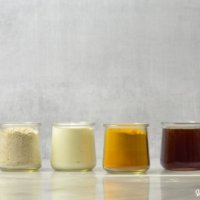
Table of Contents[Hide][Show]
Maybe you’ve heard of a honey mask, and you’ve probably done a yogurt mask at some point. But let me introduce you to a turmeric face mask. Rich in antioxidants this mask helps reduce inflammation, tame acne, and improve skin tone.
Turmeric Face Mask
Turmeric has many uses, but it’s most famous for its ability to reduce inflammation in the body. I like whipping up some turmeric golden milk or a turmeric cinnamon latte. Sometimes I’ll even brush my teeth with it to help remove stains (yes, really!).
We can also use turmeric for skincare. Word of caution here though. Turmeric will stain skin, fabric, and certain surfaces, so proceed with caution. And no, we’re not going to look like Oompa Loompas after this, but be careful not to go overboard with the turmeric.
Benefits of Turmeric for Skin
Much like how turmeric fights inflammation in the body, it also helps reduce inflammation on the skin. 2019 research in the journal Nutrients looked at curcumin, the main active ingredient in turmeric, for different skin complaints. Researchers found curcumin helped with psoriasis, eczema, and other inflammatory skin conditions.
Turmeric has a long history of use in India and other countries, both for cooking and skincare. It’s traditionally used to brighten skin tone. A 2012 article in Phytotherapy Research points to turmeric’s ability to improve dark spots. Turmeric works by reducing the darker shade of melanin that gives skin its pigment. This is ironic since high amounts of turmeric can also stain skin. Scientists are even exploring its use in skin bronzers!
Because it’s anti-inflammatory and antioxidant, there’s evidence curcumin can help fight sun damage. Turmeric has a protective effect in reducing inflammation damage on skin. Over a dozen studies have found curcumin has a powerful effect against cancerous skin cells. This doesn’t mean rubbing turmeric paste on our skin will cure skin cancer. However, turmeric can help give our skin more of the tools it needs to protect against sun damage.
Other Ingredients in the Turmeric Face Mask
Yogurt: Grass-fed homemade yogurt tastes delicious with some coconut granola, or even in homemade ranch dressing. While turmeric yogurt may not sound that appealing for a snack, it makes for a great face mask. The probiotics in yogurt support skin’s microbiome and contain lactic acid. This lactic acid helps fight acne and promotes clear, healthy, youthful looking skin.
Dairy (and coconuts) also contain lauric acid, a fatty acid. Researchers discovered that when lauric acid is combined with the curcumin from turmeric it creates an acne and inflammation fighting powerhouse. For those with dairy allergies, coconut milk or coconut milk yogurt will also work in this recipe.
Oats: Another ingredient that’s really good for calming skin is oatmeal. While true colloidal oats are impossible to make at home, we can still harness the benefits of oats for skincare. The oat powder helps thicken the face mask so it stays put on skin and soothes inflamed or itchy skin.
You can see how I make “colloidal oats” at home here. It’s not the same as oat flour, which has the beneficial bran removed. This turmeric face mask can also double as an exfoliant since the oats help gently slough off dead skin cells.
Raw Honey: And of course, we can’t forget the raw honey. Raw honey is a skin superfood that helps to soften and cleanse. Honey’s naturally antibacterial properties make it especially helpful for skin blemishes. Raw honey also helps speed the healing of cuts and burns and can help damaged skin recover faster.
Turmeric Face Mask
This soothing face mask helps calm irritated skin while it brightens and softens.
Yield: 1 mask
Instructions
-
Combine all ingredients together until smooth.
-
To use, apply liberally to the face. Wash off after about 10 minutes.
Notes
I’ve kept the turmeric at a low amount so it shouldn’t stain skin. However, because of variations in skin tone, you may want to do a patch test on the back of your hand first. Cut back on the turmeric powder if necessary.
More Face Mask Recipes to Try:
What are some of your favorite ways to use turmeric? Leave us a comment and let us know!
Sources:
- Arct, J. et al. (2014). Evaluation of Skin Colouring Properties of Curcuma Longa Extract. Indian J Pharm Sci. 76(4): 374–378.
- Liu, C. H., & Huang, H. Y. (2013). In vitro anti-propionibacterium activity by curcumin containing vesicle system. Chemical & pharmaceutical bulletin, 61(4), 419–425.
- Vaughn, A. R., Branum, A., & Sivamani, R. K. (2016). Effects of Turmeric (Curcuma longa) on Skin Health: A Systematic Review of the Clinical Evidence. Phytotherapy research: PTR, 30(8), 1243–1264.
- Vollono, L. et al. (2019, Sep). Potential of Curcumin in Skin Disorders. Nutrients, 11(9): 2169.
